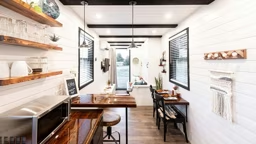Fireplaces and heating stoves have always provided beauty and cozy warmth. Now with home heating costs soaring, cabin owners want the hearth to be more than just a pretty face, they want it to cut utility bills, too.
“Clearly, homeowners are concerned about next year’s heating season,” explains Leslie Wheeler, director of communications for the Hearth, Patio & Barbecue Association (HPBA). “They’re looking for secondary sources of heat. And, of course, the Green Movement is making homeowners more aware of [alternative fuels].”
The good news is your fireplace or woodstove can reduce your cabin heating costs by 20 to 40 percent. How? The easiest way is to use a fireplace insert or stove for supplemental zone heat. By boosting temperatures in the area where you spend the most time, you can keep the central thermostat low and not pay to heat unoccupied rooms.
Even greater cost-savings are found in specially designed, super-efficient fireplace and stove units that can heat the entire cabin. These units are linked to furnace and boiler systems, which pump heat throughout the home, heat water for radiant heat and even heat the hot water supply.
How much you save also depends on the type of fuel you choose. Here are the options this heating season.
GASSING UP
For years, gas fireplaces, inserts and stoves have been extremely popular with consumers, representing 1.5 million of 2.4 million new hearth units. And with push-button, on-off convenience; no lugging of fuel; and no clean up, it’s easy to understand why. But as prices of propane and natural gas increase, consumers are turning to other, less expensive fuels — and sales of gas hearth products have leveled off.
Still, a gas stove can be an effective zone heater, according to Wheeler. “You can save money on overall heating costs by using a gas stove to warm the rooms you’re using.”
WOOD BY THE CORD
With firewood prices significantly lower than other fuels, there’s been a major increase in the demand for wood stoves and inserts, according to Wheeler. Manufacturers report that first quarter 2008 shipments of wood stoves were up 57 percent over last year. And, new technology has led to cleaner-burning wood appliances. In fact, new EPA-certified wood stoves have up to 90 percent fewer emissions than older non-certified units.
WOOD BY THE PELLET
“Pellet stoves are going out the door faster than during the oil embargo of the 1970s,” explains one industry expert. Credit that to comparatively inexpensive pellet fuel prices, and the fact that pellets, made from compressed, recycled wood waste, are a renewable resource — something that is becoming increasingly important to consumers.
But while pellet fuel manufacturers are ramping up production to meet the increased demand this heating season, some industry sources report shortages of pellet fuel in pockets of the country, particularly the northeast.
ALTERNATIVE FUELS
Often unfairly mistaken for its dirtier cousin, anthracite coal is actually clean burning and among today’s least expensive hearth fuels. The fuel has limited distribution, which has kept anthracite-fueled stoves from completely catching on, but if it is available in your area, it might be worth considering.
With corn in demand for other types of energy, prices are up and supply is down dramatically for hearth fuel, making corn stoves less cost-effective this year. Other biomass agricultural waste by-products — including oat hulls, cherry pits and sunflower seed hulls — are being developed as hearth fuels but these are not yet mainstream.
ON THE HORIZON
The hearth industry is currently developing hybrid appliances that can burn different fuels, giving you the ability to select fuel based on the current market’s best pricing and availability — and without having to change appliances.
Until that time comes, HPBA offers free online tools to help you sort out which type of hearth product is best for you. Its Consumer Guide (www.hpba.org/hearthconsumerguide) compares different hearth options, fuels, efficiency and estimated purchase and installation costs. And its Fuel Efficiency Calculator (www.hpba.org/fuelcalculator) helps you compare the costs of various fuels and calculate cost-saving benefits.
Now we just need a tool that will carry firewood from the woodpile into the cabin.
Lisa Readie Mayer would prefer summer all year, but does enjoy snuggling up in front of the fireplace with her husband and two daughters.










